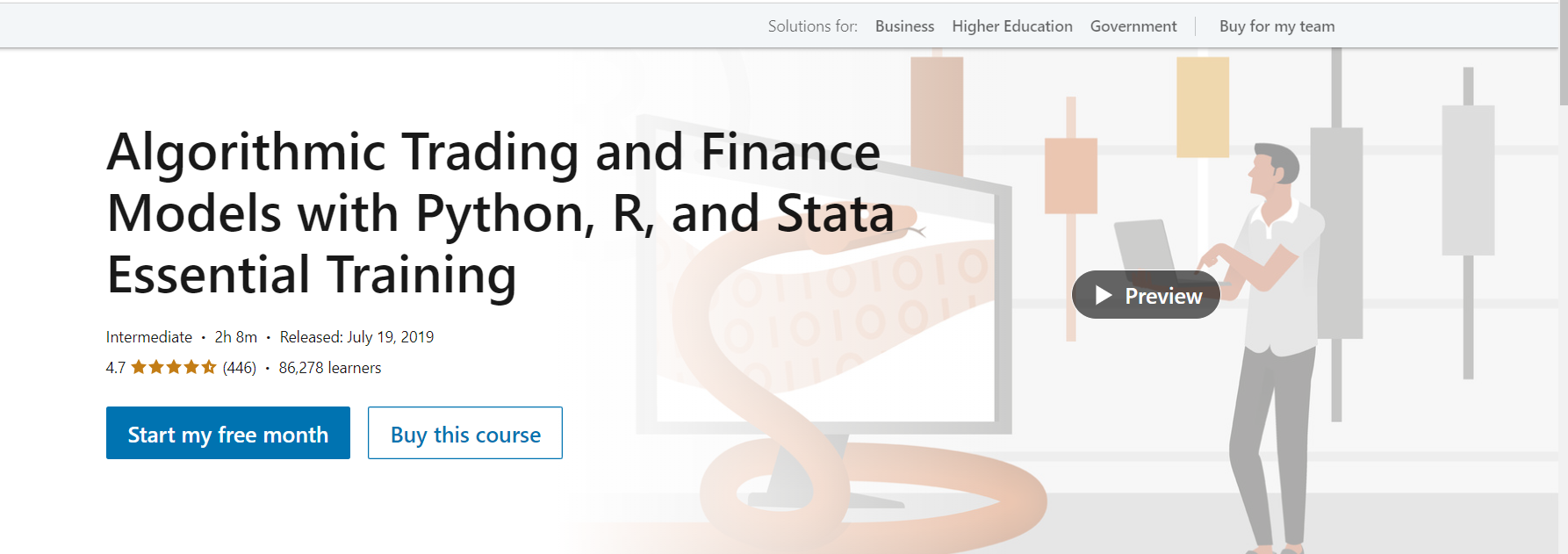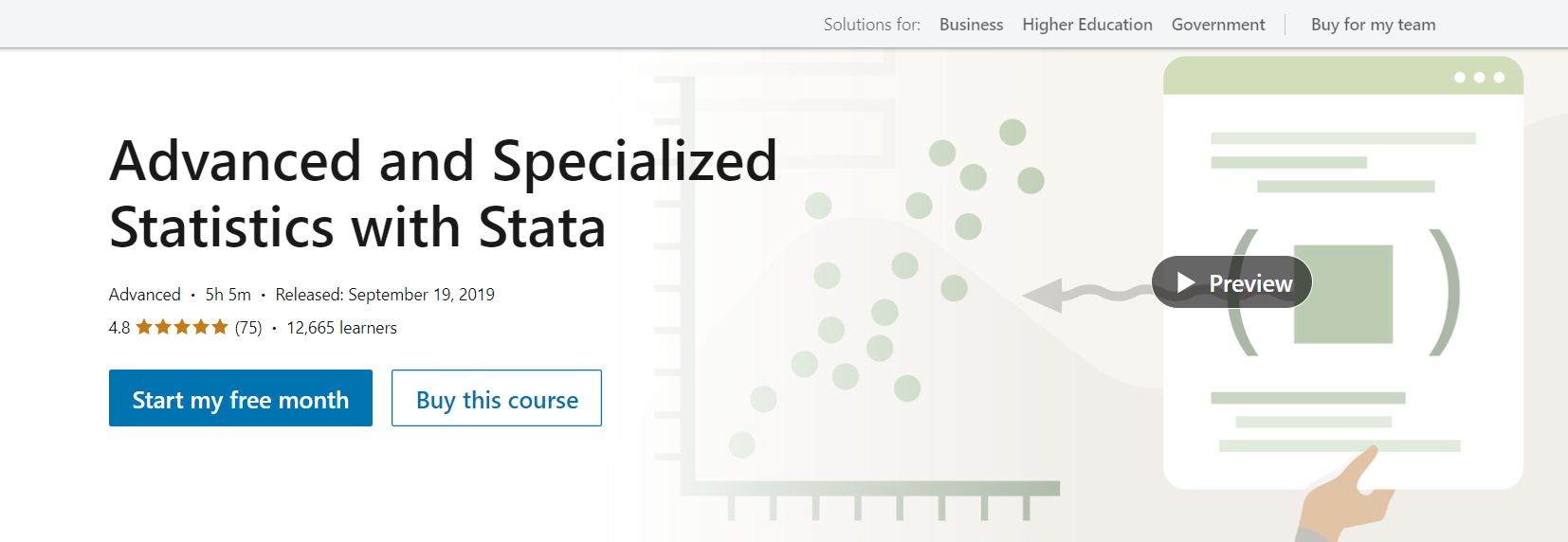Across the world, researchers, educators, and business executives utilize Stata, a statistical software program.
It provides extensive management, visualization, and analysis capabilities for data. Users of Stata can conduct a wide variety of statistical analyses, from detailed descriptive statistics to sophisticated econometric models.
The programming language in Stata enables users to automate challenging processes, alter studies, and produce reusable research.
Thanks to its user-friendly interface and comprehensive documentation, users of all backgrounds and skill levels, from novices to experts, may utilize a Stata.
Why Study Stata?
For those interested in statistics and data analysis, studying Stata can be helpful for several reasons. Here are a few of the primary explanations:
- Versatility: From simple descriptive statistics to complex econometric modeling, Stata is a versatile piece of software that can handle various data analysis jobs.
- Popularity: Stata is a desirable skill on your CV because it is widely utilized in academia, government, and industry.
- User-friendly: Stata is accessible for beginners to learn and use thanks to its user-friendly interface and syntax.
- Reproducibility: Stata offers features for reproducible research, making it simple for users to share their code and document their studies.
- Integration with Other Software: Stata is a helpful addition to a data analyst’s toolkit because it integrates readily with software programs like Excel and R.
- Support and Community: Stata has a sizable and vibrant user base, and many online resources and help forums are available.
List of Best Online Stata Courses
In this blog, we have listed the top 10 free and paid Stata courses that you may take in 2023.
These courses cover many Stata abilities and applications, from beginner courses to advanced topics, including panel data analysis and financial forecasting.
A Stata course on this list can help you accomplish your goals, regardless of whether you’re a student, researcher, or working professional.
1. Introduction to Statistics [Coursera]

You can learn the foundational ideas of statistical reasoning, which are essential for understanding data and effectively presenting insights, in Stanford’s “Introduction to Statistics” course. After completing the course, you’ll be able to undertake exploratory data analysis, understand the fundamentals of sampling, and choose the most appropriate tests of significance for different situations. In addition, the course gives you a solid foundation to prepare you for more difficult statistical reasoning and machine learning topics.
The Topics Included are:
- Common tests of significance
- Regression
- Resampling and multiple comparisons
- Descriptive statistics
- Sampling and randomized experiments
- Central limit theorem
Total time – 15 hours
Level – Beginner
Lectures – 82
Certificate – Yes
Cost – Free
2. The Essential Guide to Stata [Udemy]

It might be challenging to learn and use new statistical approaches. This is particularly true when dealing with “real life” data sets, which do not lend themselves to simple “click-and-go” analysis but require a more profound comprehension of program coding, data manipulation, output interpretation, output formatting, and choosing the appropriate analytical methodology.
This course will give you a thorough introduction to Stata and its diverse applications in contemporary data analysis.
The Topics Included are:
- Introduction to Stata
- Data viewing, exploration, and manipulation
- ANOVA and correlation
- Diagnostics and regression (Ordinary Least Squares)
- Creating regression models
- Testing hypothesis
- Check the full list here.
Total time – 14.5 hours
Level – Beginner to advanced
Lectures – 103
Certificate – Yes
Cost – Paid
3. Modeling Count Data using Stata [Udemy]

The first lesson in the course covers count tables and teaches students how to compute the incidence rate ratio. Students learn how to use Stata to apply what they have studied in the second section of the course. Students will work through an assignment in this section to fit Poisson, negative binomial, and zero-inflated models.
The Topics Included are:
- Comprehend count tables
- Compute incidence-rate ratios.
- Recognize count models
- Determine when to employ count models
- Regression Poisson
- Negative binomial regression
- Model truncations
Total time – 3 hours
Level – Beginner
Lectures – 29
Certificate – Yes
Cost – Paid
4. Algorithmic Trading and Finance Models with Python, R, and Stata Essential Training[LinkedIn Learning]

This project-based course is intended for anyone interested in financial investment and business analytics. Michael McDonald, a specialist in the industry, teaches you how to create quantitative, testable investment rules for wise trading decisions using programs like Excel, Python, R, or Stata. Both algorithmic trading and how to develop a trading strategy will be covered. In addition, Michael investigates the software already in use in great detail and offers tips on finding opportunities across various industries.
The Topics Included are:
- Algorithmic Trading
- Python
- R ( Programming language)
- Stata
- Financial Modeling
Total time – 2 hours 8 mins
Level – Intermediate
Lectures – 4
Certificate – Yes
Cost – Paid
5. Stata Training [Stata]

This course is perfect for you if you’re seeking a handy Stata course appropriate for students of all skill levels. It covers many subjects, including developing your Stata commands, analyzing Univariate Time Series with Stata, and using Stata to analyze panel data. The instructors are skilled and exciting, and the course provides both online and in-person training choices. This course offers a detailed introduction to the subject and is recommended for anyone looking to expand their understanding of Stata programming and analysis.
The Topics Included are:
- The course is reasonably priced, giving students a provisional license to practice the courses.
- The course includes two hundred fifty recordable video tutorials for learning and problem-solving.
- Both online and in-person students can access the same materials.
- Students can ask for a certificate of completion once the procedure is finished.
Total time – 23-30 hours
Level – Beginner
Lectures – 89
Certificate – Yes
Cost – Paid
6. Advanced and Specialized Statistics with Stata [LinkedIn Learning]

Students will learn more about Stata in this course, which is flexible, user-friendly, and quick statistical software that can handle up to 120,000 variables and over 20 billion observations. This advanced and specialized course, taught by Franz Buscha, explores subjects including panel data modeling and interaction effects in regression models. The course also covers advanced topics, including count data analysis, survival analysis, and Monte Carlo simulations.
The Topics Included are:
- Information on Data Management
- More on Methods for Visualization
- Regression Model Interaction Effects
- Modeling Panel Data, fourth
- Simulation and Random Numbers
- Simulation of counts
Total time – 5 hours 5 min
Level – Advanced
Lectures – 8
Certificate – Yes
Cost – Free
7. Data, Economic Modeling, and Forecasting with Stata [LinkedIn Learning]

Jason Schenker, a financial specialist, teaches Stata forecasting techniques, fundamentals of economic modeling, and other topics in this course. Jason assists students in analyzing statistical data and emphasizes the need for iterative data modeling, focusing on univariate and multivariate linear regression models. The mean, standard deviation, standard error, coefficients, independent variables, and confidence intervals are just a few of the crucial forecasting statistics that Jason addresses. He highlights significant data practices, including the distinction between correlation and causation; he also examines the value of excellent data, big data, and risk management while developing forecasting models.
The Topics Included are:
- Fundamental
- Modeling Essentials
- Screencap Stata Fundamentals
- Advanced Topics
Total time – 49 mins 22 seconds
Level – Beginner
Lectures – 5
Certificate – Yes
Cost – Free
8. Data Analysis with R Specialization [Coursera]

This Specialization course will help you improve your data analysis and visualization skills using R to create reproducible reports. In this course, you will study everything there is to know about statistical inference, including how it is unified. You will learn to perform regression, Bayesian statistical inference, and modeling to comprehend natural events and make intelligent decisions. Also, you’ll discover how to convey statistical findings without going into jargon.
The Topics Included are:
- Introduction to Probability and Data with R
- Inferential Statistics
- Linear Regression and Modeling
Total time – 5 months
Level – Beginner
Lectures – 3
Certificate – Yes
Cost – Paid
9. Data Management and Analysis with Stata [Udemy]

The course is divided into 7 sessions to give students a solid introduction to Stata and Statistics. Its goal is to acquaint students with all statistical variables, including nominal, ordinal, interval, and ratio variables, and the pertinent Stata commands.
The Topics Included are:
- Knowing stats
- Fundamental commands
- Data management
- Statistics – descriptive
- Nominal / Ordinal variables analysis
- Regression analysis
Total time – 7.5 hours
Lectures – 67 lectures
Level – Beginner to advanced
Certificate – Yes
Cost – Paid
10. Statistics Explained Easy 5 – STATA [Udemy]

The fundamentals of STATA are covered in this course before moving on to more complex subjects like data manipulation, descriptive statistics, hypothesis testing, regression analysis, and graphical representation. The lesson plan is laid out clearly and includes exercises and real-world examples to assist students in better understanding the concepts. This course is offered on Udemy, which can be finished at the student’s pace.
The Topics Included are:
- Opening a Stata or Excel file in Stata
- Introduction to Data View
- Ascending, descending, and creating a count variable
- Manage Variable and value labels
Total time – 39 mins
Lectures – 10
Level – Beginner
Certificate – Free
Cost – Paid
Conclusion
As a robust statistical tool for data analysis, modeling, and visualization, Stata is employed by researchers, analysts, and companies worldwide.
Learning Stata can be a valuable skill for professionals trying to progress in their jobs or students aiming to thrive in their academic endeavors. This course has excellent career options in today’s world due to the growing demand for data-driven decision-making in various industries.
In addition, those with multiple learning requirements, interests, and financial constraints can choose from these Best Online Stata Courses & Classes 2023 described above.
So pick the program that best meets your needs and get started on the learning path!
Frequently Asked Questions
Is Stata better than Python?
Stata can be a better option if your main focus is statistical analysis and you only need a few programming skills. When it comes to statistical analysis, Stata has several benefits over Python. It is simple to conduct complex statistical analysis without developing custom code, thanks to its extensive built-in statistical functions. Moreover, Stata has a thriving user base, so tons of help and documentation is available. Ultimately, the choice between Stata and Python depends on the unique demands of the user. Python might be a better option if you need more customization and flexibility or wish to use it for purposes other than data analysis.
Are Online Stata Courses Good for Inclusion on Resume?
Yes, an online Stata course can add value to your resume, especially if you’re looking for work in a field that needs people with data analysis skills. Employers will see that you took the initiative to gain new skills and advance your data analysis talents by finishing an online Stata course. It also demonstrates your passion for data analysis and dedication to lifelong learning.
Does Stata Require Coding?
Stata demands programming in its unique command language, similar to other programming languages. Users must write commands to handle data, perform statistical analyses, and produce output in Stata. However, Stata includes a graphical user interface (GUI) that enables users to perform fundamental operations without writing code. The GUI can be useful for viewing data, producing detailed visuals, and carrying out rudimentary analyses, but coding is typically needed for more challenging tasks.





